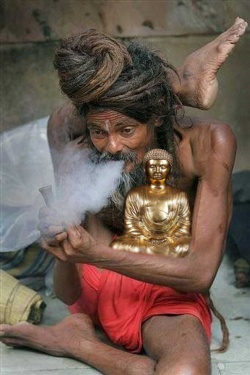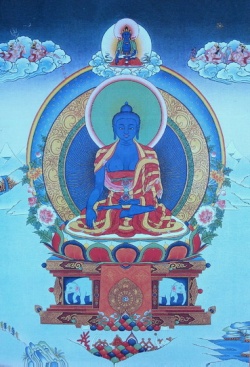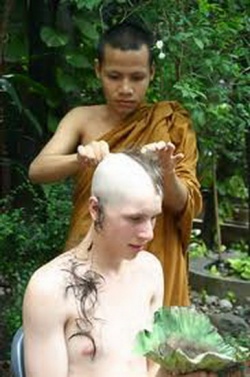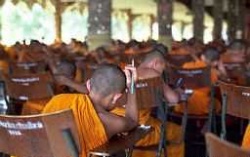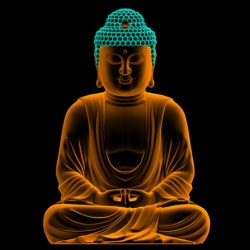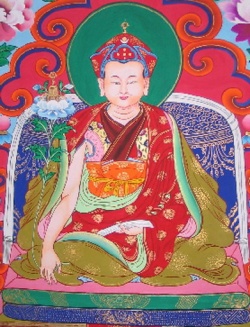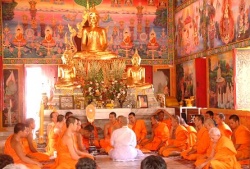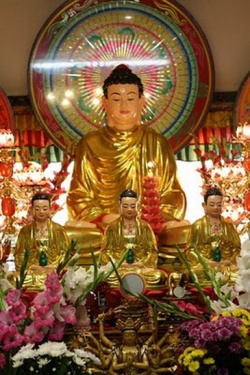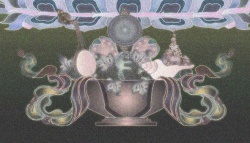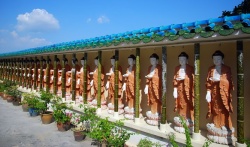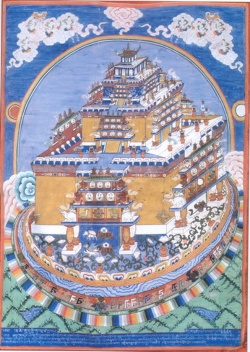A Buddhist’s Insight into the 12 Steps of Recovery
by Doug C.
A Short Introductory Not
Many people in recovery discover and investigate Buddhism as a spiritual path because the 11th Step advises us to meditate, and the various Buddhist traditions, over the last 2,500 years, have developed many comprehensive and sophisticated systems of meditation. Another reason Buddhism appeals to a broad range of people in recovery is because it is an experiential spiritual practice that empowers us to improve our conscious contact with a Greater Power of our understanding through rational investigation, contemplation, and profound insight, rather than a religion that requires blind faith of its followers.
From the very beginning of his ministry, the Buddha invited his disciples to investigate his teachings and prove their legitimacy for themselves before accepting them. In fact, the Kalama Sutra recalls the Buddha’s words on accepting religious teachings on blind faith this way: “There is no use going by tradition or lineage, by what others say or what others have written or the teacher’s authority. When you know for yourself that these ways are wholesome, that these ways are praiseworthy, that these are the ways approved by the wise, that these ways, followed and practiced, will certainly lead to well-being and happiness, then these ways must be the ways to follow.” Buddhism’s sound empirical approach to spirituality may be the reason that Albert Einstein said, “Buddhism has the characteristics of what would be expected in a cosmic religion for the future: It transcends a personal God, avoids dogmas and theology; it covers both the natural and the spiritual, and it is based on a religious sense aspiring from the experience of all things, natural and spiritual, as a meaningful unity.”
Both the 12 Steps and Buddhism are practices that deal with addiction and craving as the cause of our suffering and prescribe proven methods of recovery. 12-Step Buddhism is a complementary practice for the recovering addict that combines basic Buddhist practices with traditional 12-Step techniques and offers us a powerful path to freedom that plunges below the surface of addiction and addresses its causes. It isn’t a replacement for a traditional 12-Step program, but a supplemental practice proposed to help us experience our recovery on a deeper level by applying Buddhist techniques and insights; some, like the Five Moral Precepts and the Eightfold Path, are specific to Buddhism and not a traditional part of formal 12-Step programs. For that reason, we maintain, and encourage newcomers to establish, a working relationship with a home recovery group. Furthermore, we diligently work our home group’s program while enriching and strengthening our recovery with our Buddhist practice. Because of the countless forms that the disease of addiction takes, all manifesting if untreated in an endless cycle of suffering, 12-Step Buddhism doesn’t just concentrate on any one form of addiction, but addresses all forms of unmanageable craving.
This booklet is a contemplation of the 12 Steps of Recovery from a Buddhist’s perspective. It is inspired and based on works written by Darren Littlejohn, Kevin Griffin, Noah Levine, Laura S. and other groundbreaking pioneers in the Buddhist recovery movement. Some of the language of the traditional 12 Steps has been revised in order to correspond more consistently with a Buddhist understanding of 12-Step concepts, like higher power, turning over, and surrendering our will. Each of the 12 Steps has a short description of Buddhist beliefs, doctrines, and practices corresponding to the basic principle underlying the individual step. This booklet is intended to be nonsectarian and draws upon the wisdom and practices of several Buddhist schools and traditions. However, as you might expect, my insight has been broadly influenced by the beliefs and practices of the Buddhist denomination to which I belong, Shin Buddhism, which is a Japanese Pure Land school from the Mahayana branch of Buddhism.
This booklet is my gift to my sisters and brothers in the Worldwide Buddhist Recovery Sangha. Please copy and distribute freely.
Palms Together in Boundless Love and Respect,
A Buddhist’s Insight into the 12 Steps of Recovery
STEP ONE: We admitted that we were powerless over our craving and addiction and that our lives have become unmanageable.
The Buddha taught in the First and Second Noble Truth that life is permeated with suffering and that ignorance, delusion, and craving are the cause of our suffering. In other words, that our addictions not only to various substances and behaviors, but also to unwholesome and unskillful beliefs, attitudes and thoughts, have trapped us in a vicious cycle of suffering that is beyond our control. According to the Buddha’s teachings, this cycle begins with ignorance and delusion, which initiates a chain reaction, called nidanas in Sanskrit that leads to our craving that in turn leads to our suffering. One example of ignorance and delusion is when we are in denial about our addiction while it is making our lives unmanageable and causing us unbearable suffering. This unbearable suffering leads us to engage in our addiction again and again as this cycle of suffering continues.
STEP TWO:
We came to believe that a Power greater than our individual selves could restore us to wholeness.
The Buddha taught in the Third Noble Truth that there is a way to transcend our cycle of craving and suffering. The Buddha’s teachings from beginning to end were all centered on how to cope with and move beyond our cycle of craving and addiction, and its inevitable consequences, which are the grief, distress, and agony that we cause in our own lives as well as in the lives of the people that we touch. The Buddha’s teachings will, over time, lead us to a deep personal insight into our interconnectedness with a Power that is greater than ourselves and yet is not separate from ourselves, and what that relationship means to our recovery.
STEP THREE
We made a decision to take refuge in and entrust ourselves to the compassion and guidance of a Greater Power of our understanding.
As part of our Buddhist practice for surviving and moving beyond our craving and suffering, we “take refuge” in the Buddha, the Dharma, and the Sangha, also called the Three Jewels. “The Buddha” not only refers to the historical Buddha, but also the Oneness of the Universe, the True Nature of all beings (including ourselves) and to all the boundless manifestations of Buddhahood, including our teachers, sponsors, and mentors. “The Dharma” is the teachings of Buddhism, the path to recovery, Universal Law, and Reality-as-it-is. “The Sangha” refers to our Buddhist community, both local and worldwide, and our recovery fellowship. Buddhists around the world devote profound prasada, a Sanskrit word that means “lucid-serene-trust,” to all the countless facets of the Buddha, the Dharma and the Sangha as a Greater Power. Taking refuge means that we turn to the Three Jewels not only as a shelter from our craving and the suffering that it causes, but also as a light to guide us through the darkness of our ignorance and delusion.
STEP FOUR
We made a searching and fearless moral inventory of our thoughts, words, and deeds.
The Buddha taught that our thoughts, words, and actions have an effect on our own lives as well as the lives of others and on the entire world. We call this basic principle karma, a Sanskrit word that means “action.” The Law of Karma establishes that we do indeed participate in the creation of our own lives. Therefore, our recovery is deeply dependent on acknowledging that our actions do actually matter and sincerely taking ownership of the consequences of our actions. As long as we continue to cast ourselves in the role of victim and absolve ourselves of any responsibility for our own circumstances and experiences, we continue to lack the motivation to transform our attitudes, behaviors, and, ultimately, our lives. By directly and openly bearing witness to the nature of the suffering and pain that we inflict on ourselves and others, we are propelled into action that will transform our lives and the world.
STEP FIVE
We admitted to ourselves, our Greater Power, and another human being the precise moral nature of our thoughts, words, and deeds.
The Buddha during his lifetime initiated a ceremony called upavasatha, which is a Sanskrit word that means “cleansing of the defiled mind.” In this ceremony, disciples of the Buddha admitted to their fellow Sangha members the nature of their unskillful and unwholesome thoughts, words, and deeds in order to deepen their spiritual practice and experience greater inner tranquility. When we share with another human being the exact nature of our internalized guilt and shame we take a vital step along the path of recovery and true spiritual healing. The act of telling someone our darkest secrets allows us to step back from our stories and their related feelings, beliefs, and behaviors, and bring them into the light of integrity. We can then look at them objectively so that we can see deeply and more clearly the suffering that we have caused ourselves and others. Sharing with another person also gives us needed feedback so that we can see from the perspective of an objective, nonjudgmental observer where we are distorting our stories, either to diminish our responsibility or to assume an unrealistic and overwhelming burden of blame. Upavasatha, or “admitting the precise nature of our unwholesome and unskillful behavior,” is not only critical to our recovery, but it also heals us spiritually as well as helps to mend our fractured relationships.
STEP SIX
We became entirely ready to have our Greater Power transform our unwholesome characteristics into wholesome ones.
The Buddha taught the principle of naiṣkramya, a Sanskrit word that means “renunciation and freedom from craving and clinging,” as one of the paramitas or virtues that lead to spiritual awakening. In preparing for transformation, we must become willing to let go of our unwholesome qualities and allow our Greater Power (of our understanding) to transform them into wholesome ones. By taking refuge in our Greater Power, then letting go of and turning over the unwholesome aspects of our personalities and their interconnected, entrenched habit energies and related behaviors, we are able to become one with our recovery process in a way that is greater than our own ability to control or to predict the final outcome. The Buddhist doctrine of naiskramya means not only renouncing our unwholesome characteristics, but also letting go of control over the process and not trying to manipulate the outcome. It is only when we let go of trying to manage a future, which is unknowable and in reality is subject to countless factors that are beyond our control, that we can truly live in the present moment. The present moment is where our lives are actually taking place, and it is always in the present moment that all transformation and liberation occur.
STEP SEVEN
We humbly turned our unwholesome and unskillful qualities over to our Greater Power to be transformed into positive ones.
The Buddhist doctrines of anatta and sunyata teach us that everything we encounter, including ourselves, has no absolute permanent identity or characteristic. These two teachings reveal the truth that not only is change possible, but in reality change is inevitable and unavoidable. Anatta is a Sanskrit word that literally means “Not-Self,” or that there is nothing about us that is not subject to change, nothing about us that is permanent, nothing about us that is not dependent upon environmental causes and conditions.
Sunyata is a Sanskrit word that means “emptiness”—in other words, that all things in existence are impermanent, with no perpetual state of being, and are in a constant state of flux, undergoing continuous transformation. It is important to understand that anatta and sunyata are not denials of our existence or the existence of the material world, but rather that everything about us and our characteristics—spiritual, mental, and physical; wholesome and unwholesome—and even our situations and environments, are constantly undergoing transformation, which is determined by our karma, which is itself also subject to emptiness and impermanence, and as a result is changeable. This means that we are not trapped by our habit energy and that we can truly experience a complete transformation of our unwholesome and unskillful qualities, into positive, wholesome ones. Another aspect of anatta is humility, a deep understanding that we are not special—not higher and not lower not greater and not lesser—but rather share the same universal nature with all sentient beings. This is our Buddha nature; this is who and what we really are, and it is through this universal goodness and universal compassion that we can be restored to sanity. As part of the upavasatha, or “cleansing the defiled mind,” many Buddhists say an Atonement Prayer, similar to the one below, as a way of asking for their unwholesome and unskillful characteristics to be transformed into positive ones.
All evil karma ever committed by me since before time,
Because of my vast greed, anger, and ignorance,
Born of my body, mouth, and mind,
I now atone for it all.
May it be transformed for the good of all beings.
STEP EIGHT
We made a list of all persons we had harmed, and became willing to make amends to them all.
According to Buddhist teachings on Karmic Law, our intentions give rise to our karma or actions; from our actions karmic seeds arise, which then ripen into karmic results or vipaka, a Sanskrit word meaning “ripened fruit.” Desirable vipaka is the result of skillful and wholesome actions, and undesirable vipaka is the result of unskillful and unwholesome actions. Moreover, our karma is both continually ripening and continually being generated by our current actions. This means that it is entirely possible to reshape our future karma and its ripening fruit through the choices and actions that we embrace and carry out today. Cetana, a Sanskrit word meaning “intention,” is not only the energy source from which our karma is generated, it is also the energy source from which our karma can be neutralized.
This is because our intentions are the primary mover of all of our other mental actions, like feelings and thought, and determine the direction of our mind, which then determines our behavior and actions, or our karma. Buddhism teaches that we can purify negative karmic seeds through the Four Purifying Powers, which are: the Power of Regret, the Power of Promise not to repeat the action, the Power of Repair or making amends, and the Power of Remedial Actions or service to others. But all these powers rely on our cetana. When we make a list of all persons we have harmed and become willing to make amends, we activate the Power of Regret, as well as the Power of Promise not to repeat the action, and we set our intention, which is the source energy of all positive and negative karma. As we touch the sadness, as the tears arise and as we face the devastation we’ve caused in the lives of our loved ones and the other people on our list, it is the Power of Regret that gives rise to the Power of Promise not to repeat our (unwholesome and unskillful) actions, and our intention to engage the Power to Repair or make amends.
STEP NINE
We made direct amends to such people wherever possible, except when to do so would injure them or others.
The final two Purifying Powers of Buddhism, the Power of Repair and the Power of Remedial Actions, are directly related to and are put into action by making amends. The Powers of Repair and Remedial Action contain the power to heal and to transform our past karma and its results. First we transform ourselves from being a person who avoids accepting responsibility for our actions into a person who takes responsibility for our actions. Next when we confront the reality that we are imperfect just like everyone else, and that we too make mistakes just like everybody else, the negative emotions that gave rise to our harmful actions are neutralized and transformed into positive emotions that give rise to beneficial actions. In Buddhism we believe that negative emotions are unwholesome states that interfere with our spiritual development.
So by transforming our negative emotions, through the humility it takes to truly own and admit to our mistakes, the roadblocks that obstruct our recovery are transformed into what are referred to in Buddhism as the Four Heavenly States: of Loving-kindness, Compassion, Sympathetic Joy, and Equanimity. Another transformative power of making amends is the power of forgiveness. Yes, forgiveness from others feels good, but just as important is that we forgive ourselves. We have to offer and accept self-forgiveness; while we all have harmed others through our unskillful and unwholesome acts, or negative karma, the not-so-obvious victim of our “wrongdoing” is us. Every harmful action we engage in leaves us coping with the emotional weight of being a “bad person.” As we engage the Power of Repair and the Power of Remedial Actions on the physical level by apologizing to the people that we harmed, making restitution that is appropriate to our resources, performing community-service work as well as individual selfless actions that benefit other beings, we can also invite spiritual healing and transformation through metta, or “Loving-kindness” meditation. This is a traditional meditation that was taught by the Buddha himself to his disciples. In metta meditation, we hold a person in our mind and recite phrases like:
“May you be safe, may you be well, may you be happy, and may you live in peace.”
We can use the above phrases or other words with similar meaning that feel more natural to us. In traditional Metta meditation we begin with someone who is “easy” to feel kindness toward. Then we expand our meditation to include others in our life, even people who we may have a difficult relationship with. And, ultimately, we include all beings in the world. This meditation helps us to heal relationships in our own mind, even when the person doesn’t want to talk to us, when we can’t make direct amends, when we can’t find the person for some reason, or even when that person has died.
STEP TEN
We continued to remain mindful of our mental, verbal, and physical actions, and when we acted unskillfully, promptly admitted it.
Buddhist teachings advise us that it is more beneficial to avoid the creation of karmic seeds than to worry about ripening karmic fruit. It is the karmic seeds that we create through our mental, verbal, and physical actions that trap us in our cycle of addiction, craving, and suffering. This means that we need to be continuously mindful of our thoughts, words, and actions, and be ready to apply the Four Purifying Powers the moment we become aware that we somehow slipped up or harmed someone. This will prevent our becoming caught in a cycle of attachment, resentment, and denial, as well as prevent the accumulation of negative karmic seeds. Buddhist ethics are primarily based on the understanding that we’re interconnected to all life and that anything we do to any other living being we ultimately do to ourselves. However, this concept is rather abstract, and using it as a guide to determine when we need to make amends may be a little tricky. So, one useful and undoubtedly more straightforward ethical compass that can help us find some clarity on our actions and their karmic implications is the Five Moral Precepts. These precepts were taught by the Buddha as a guide for his lay disciples and have been handed down over the last 2,500 years, benefiting each generation until they were inherited by us in our time. The application of the precepts is simple: if our actions are somehow outside the principles and parameters of these precepts, then we probably need to make amends. While the precepts are more guidelines than commandments (and strictly speaking not part of a traditional recovery program), ideally, we would want to try to live in harmony with them not only as a way to live a more happy and wholesome life, but also as wonderful guidelines to help us maintain our sobriety. Each of the Five Moral Precepts is listed below with an affirmative aspect that is the foundational spirit that the precept is based on, which in turn generates positive karma, and a type of behavior to avoid because it generates negative karma.
I embrace the teaching of loving-kindness; I abstain from harming others. This precept counsels us to avoid intentionally hurting or killing any living being. But it also means that we should not be the cause of—or approve of—harm coming to any living being. This precept is not only appealing to us to avoid doing harm to their physical bodies, but likewise to refrain from inflicting mental, emotional, and spiritual injury as well. Moreover, it means that we should try to treat all beings with kindness and compassion.
I embrace the teaching of generosity; I abstain from taking things not freely given. This precept counsels us not only to abstain from cheating and stealing, but it actually advises us to avoid participating in, through commission and omission, all forms of exploitation, injustice, and oppression, and to cultivate generosity and loving-kindness toward all living beings.
I embrace the teaching of respect for all beings; I abstain from sensual misconduct. This precept counsels us to abstain from sexual abuse or other sexual activities that cause harm to ourselves and others, to abstain from sexual relations without love and a long-term commitment, as well as to honor our commitments and the commitments of others. But there is an additional bit of guidance as well: to avoid immoderate indulgence in any physical or sense pleasure such as overeating, overindulgence in entertainment like video games or television, or other compulsive escapist behaviors.
I embrace the teaching of mindful communication; I abstain from deception and discord. This precept counsels us to avoid false and insincere speech, as well as speech that is harsh, harmful, and slanderous. It also advises us to cultivate speech that is loving, beneficial, and intended to bring happiness to others. Another aspect of mindful communication is deep listening; often the most compassionate discourse we can offer to others is to simply be present for another person and truly witness his or her life experiences, both joyful and sorrowful.
I embrace the teaching of mindfulness; I abstain from substances and actions that lead to intoxication and heedlessness. This precept counsels us to cultivate mindful consumption and sobriety and to abstain not only from drugs, alcohol, and other intoxicating substances, but also to avoid anything that has toxic effects, such as pornography; certain films, television programs, books, magazines, foods, and activities (like gambling or enabling another person’s addiction); or even some conversations. Keeping this precept benefits our own mental, spiritual, and physical health, and promotes our families’ and communities’ well-being, too. Embracing and keeping the Fifth Precept not only helps us to avoid indulgence in substances that could cause us to disregard the first four precepts, but also for those of us in recovery, it is a vital tool for preventing our relapse or even developing new addictions that would seize control of our lives and return us to our former wretched existence.
STEP ELEVEN
We engaged in meditation and prayer in order to improve our conscious contact with our Greater Power (of our understanding) and to gain the insight and strength to realize and attain our Greater Power’s compassionate aspiration for us.
Most people who turn to Buddhism after entering recovery investigate it because of the wide-ranging and highly developed meditation practices found in many Buddhist traditions. All forms of Buddhist meditation, whether they be contemplation, visualization, sitting, standing, or walking, fit between and encompass the two poles of meditative practice; in Sanskrit these are called samatha, or “calm abiding” (sometimes called single-pointed concentration), and vipassana, or “clear seeing” (also known as insight meditation). Single-pointed concentration is a meditative practice where we truly not only “accept the things we cannot change,” but we also develop the courage to change the things that we can. To practice this meditation, we calm our busy minds: we sit with our breath (or some other object of concentration) and just allow our mental activity to naturally wane, returning again and again to our breath whenever our mind inevitably wanders. In this way we not only develop serenity and tranquility, we change the only thing that we truly can change, our mind. Insight meditation is a distinctively Buddhist practice that helps us to develop insight into the nature of “things,” including ourselves, through our focused attention. As we sit in awareness of our breath, body, mind, and environment, this form of meditation encourages our cultivation of “the wisdom to know the difference” between the things we can change and the things we can’t. Regardless of what form of meditation we choose, research has demonstrated that meditation has numerous medical and psychological benefits: it reduces stress hormones and boosts our immune system, alleviates past psychological traumas, and enhances our overall sense of well-being. Meditation is a powerful friend to anyone who employs it in support of their recovery.
Buddhists recognize prayer as a powerful method of meditation. Prayer is a mindfulness practice where our awareness and concentration are not only cultivated, they are also combined with our lucid-serene-trust and set into harmony with our aspirations and intentions. This union then unleashes our potential to awaken to our intrinsic Buddha nature and transform our confusion into clarity and our suffering into joy. In other words, prayer focuses our aspirations and transmits them to the Oneness of the Universe, which also includes us; from this boundlessness, the wellspring of all possibilities, and the laws of cause and effect, beneficial results arise. Our meditation practices can be either passive or active; prayer is a dynamically active form of meditation. When many Buddhists offer prayers it is often for the benefit of other beings; this opens our lives up to boundless compassion, which is greater than and embraces our individual cravings, delusions and suffering. This prayer written by Darren Littlejohn, author of The 12-Step Buddhist, is an excellent example:
“We dedicate the merits of this practice to all suffering addicts. May everyone be free of suffering, and the causes of suffering. May everyone enjoy happiness, and the causes of happiness.”
In Buddhism, we believe that we can improve our conscious contact with our Greater Power (of our understanding) through prayer and meditation. However, we also deepen our connection by leading a life that is in harmony with the Eightfold Path, which was prescribed by the Buddha, who is sometimes called the peerless physician, because the fourth of the Four Noble Truths is the best medicine for transforming our craving, addiction, and suffering into happiness. The Eightfold Path concentrates on three essential areas of Buddhist spiritual practice: Prajna or “wisdom”; Sila, or “ethical actions” such as the Five Precepts; and Samadhi, or “mental training,” such as meditation and mindfulness. In the Eightfold Path, the Sanskrit word samma means “accurate, wholesome, complete, and skillful.” While renditions of the Eightfold Path often use the English word right when translating samma, this would be less than accurate, because the opposite of Samma is not the word wrong, but rather incomplete, unwholesome, and unskillful. Below is a list of the aspects of the path in Sanskrit with English explanations.
The Noble Eightfold Path:
Samma-Ditthi: Complete and wholesome understanding of the nature of reality and the path to recovery and transformation.
Samma-Sankappa: Proper and wholesome aspiration; intention that is motivated by love, compassion, and a desire to transform our lives.
Samma-Vaca: Skillful and wholesome speech; truthful, beneficial, and nonharmful communication.
Samma-Kammanta: Skillful and wholesome action; a life based on the principle of non-exploitation of oneself and others; living in harmony with the Five Precepts.
Samma-Ajiva: Wholesome and proper livelihood; a livelihood that is based on the ethical principal of non-exploitation, that is beneficial to others and self, and that is in harmony with the Five Precepts.
Samma-Vayama: Wholesome and complete effort; consciously directing our efforts toward actions that benefit others and ourselves, and transforming our lives and our world into a pure land full of loving-kindness and compassion.
Samma-Sati: Complete and skillful mindfulness; developing complete awareness of oneself, feelings, thoughts, people, surroundings, and reality.
Samma-Samadhi: Holistic and wholesome meditation; types of meditation that enhance and develop wholesome mindfulness and understanding.
STEP TWELVE
Having realized a spiritual awakening as a result of these steps, we carry this message to others in need of recovery, and try to practice these principles in all our affairs.
In Mahayana Buddhism, a Bodhisattva is a being who has taken a vow to work for the liberation of all sentient beings before entering into Nirvana him- or herself and escaping the cycle of birth, death, and suffering. The 12th Step coincides with the Buddhist Bodhisattva Vow: “I vow to liberate numberless sentient beings. I vow to transform endless afflictions/delusions. I vow to master innumerable practices and doctrines. I vow to embody the unsurpassed Buddha Way.” Zen Master Kobo Daishi (774-885 CE) said, “The way you can tell the depth of a person’s enlightenment is by the breadth of their service to others.” The implication in this quote is not that service to others is the test or evidence of our enlightenment, but rather that service itself is our path to enlightenment, and that our own recovery, sobriety, and transformation are dependent on our service not only to all suffering addicts, but to all of humanity.
“The Buddha’s sermons destroy the root of evil; they are beautifully worded and bring great benefit. So I bow down and worship him. With these beautifully worded sermons he cures people’s addiction to pleasures.” –Nagarjuna (150-250 CE)
Several Buddhist schools, including the Pure Land School, trace their lineage back to Nagarjuna. In many Mahayana Buddhist traditions he is considered a second Buddha.
MY STORY
I’ve been hesitant to include my story. First, because I didn’t want this booklet to be about me, and second, I didn’t want to romanticize a life that was destructive, not only to myself and the people who cared about me, but also directly and indirectly toxic to innocent people who I’ve never met. Finally, I’ve always half-joked that I’d need to check the statute of limitations before I started sharing too many details of my life story. I think it is probably enough to say that one of my friends and associates used to poke fun by branding me the “kingpin of disorganized crime.” Anyway, after some discussion with a few people whose opinions I value and trust, I decided to share a bit about myself.
I was born to teenage parents, and much of my childhood was what you might expect would happen to the baby of children. Because my parents were still children themselves, they couldn’t really handle caring for a baby. So my paternal grandparents raised and cared for me during my early childhood until my father got out of prison and took me to live with him and my future step-mother. Family life with my father and stepmother was dysfunctional at best and often very violent. When I started running away from home at the age of 12 to escape the violence, the authorities became interested in why I was constantly missing at school. This resulted in the state filing incorrigible-minor charges against me, and I became a ward of the state. The state placed me in a string of foster homes, group homes and other institutions as a teenager, some of which were just as dysfunctional and violent—or more so—as my family.
My own family, for as long as the current generation can remember, has had a history of addiction and the havoc that it wreaks on people’s lives. My paternal great-grandfather, on one of his regular drunks, passed out in a snowbank and froze to death. While he was always a loving grandpa, my grandfather hid whiskey bottles all over the garage and car, and walked around with a semipermanent buzz nearly every day of his life. My grandmother was everything you could expect from a teetotaling codependent with mental illness. My father’s life came to an end, several years after I had stopped talking to him, in a downtown Los Angeles flophouse, where he died of cirrhosis at the age of 50.
True to my family tradition, I embarked on my own antisocial and self-destructive. I wasted countless days and weeks in the pursuit of, or excessively indulging in, illegal stimulants and most anything else that could get me high. I was leading a violent, drug-ravaged life, not caring whether the source of my livelihood was legal or illegal, moral or immoral, or whether I hurt someone or worse. No matter what I did or who I hurt, to me it was all just part of doing business. I was being investigated by several government and law-enforcement agencies, and half of the customers in my little storefront were undercover cops. Sadly, I never did thank the city, state, and federal officials for all the money they spent in my shop while keeping it under surveillance. I was in the middle of a turf war, sitting on my apartment floor so I couldn’t be seen or shot through my windows. I had an assault rifle lying across my lap when an intense spiritual experience shocked me and awakened me to the truth of what I was doing, where I was going, and how it was affecting the people I loved. I don’t know if my experience was a drug-induced psychotic episode or if it was actually as it appeared to me, a Buddha of light illuminating what my life had become. Tears streamed down my face. I knew what I had to do. I strode into my shop the next morning, threw the keys to my Cadillac and my building on the front desk, turned my back and walked away.
It doesn’t really matter whether I received a visit from an actual celestial Buddha. What does matter is that a few days later I found my way to a Buddhist Sangha and took refuge. While I didn’t discover the 12 Steps until a few years later, my spiritual experience changed my life. I started down a long and difficult path that eventually led me to writing this booklet, and I never looked back. What also matters is that I have a fellowship of sisters and brothers in recovery and my Sangha, who are always pulling and praying for me. And, I know from direct personal experience, that I have a Greater Power that is always there for me, that is indeed greater than I am and yet is not separate from me, and that I can truly let go and turn my passions, cravings, and addictions over to this Boundless Oneness of Existence.
About Darren Littlejohn
